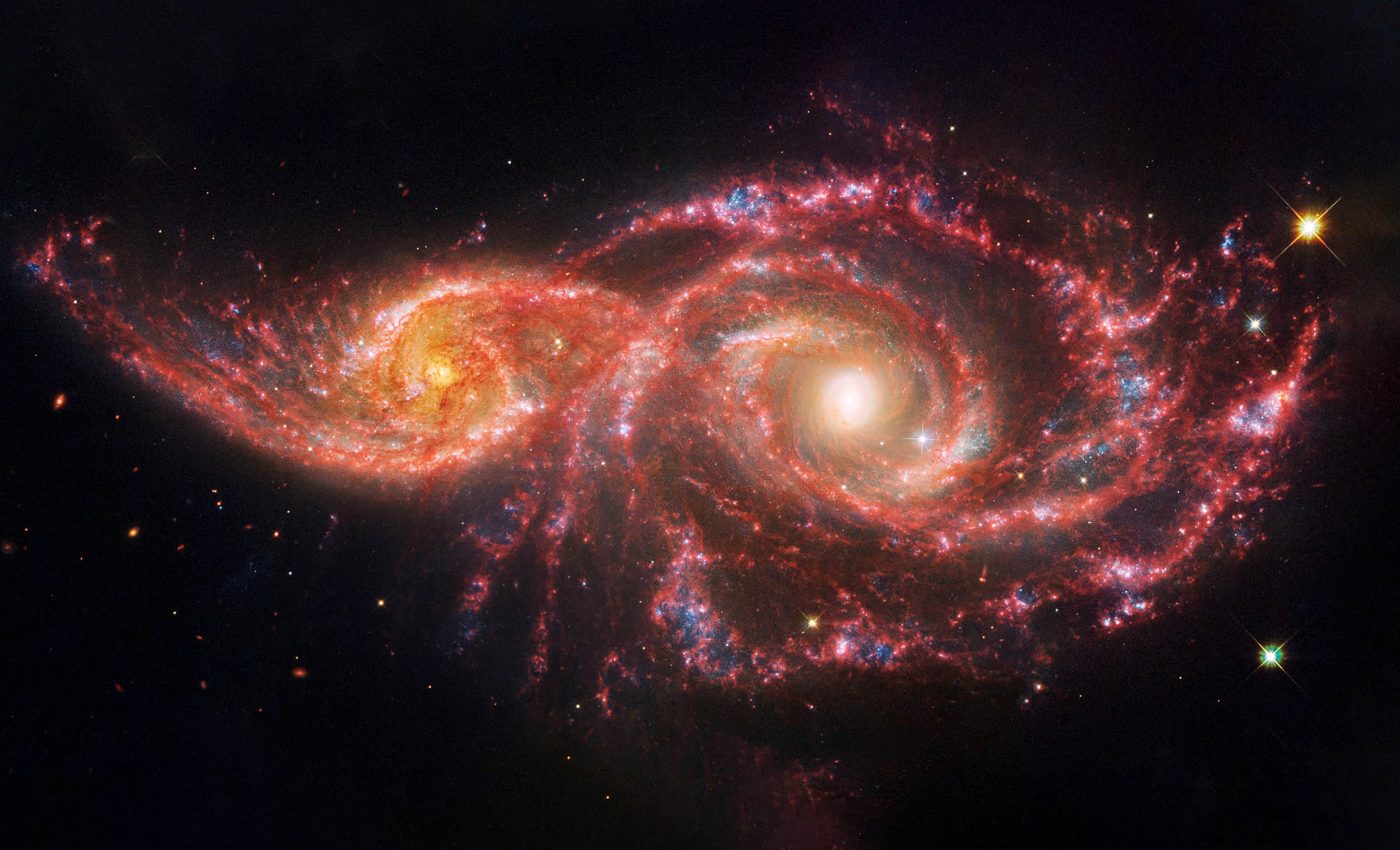
Dancing galaxies resemble bloodshot demon eyes on a black cosmic tapestry
Staring into the depths of space can feel like looking into the eyes of the universe itself. Take a moment to observe this striking image of two merging galaxies that resemble a pair of luminous eyes gazing back.
These celestial bodies, known as galaxies NGC 2207 and IC 2163, are engaged in a slow cosmic waltz that’s both spooky and enlightening.
Two galaxies have an unlikely encounter
In the grand scale of the cosmos, collisions between galaxies are not uncommon. However, the interaction between NGC 2207 and IC 2163 is particularly intriguing.
Located about 80 million light-years away in the constellation Canis Major, these two spiral galaxies have begun a gentle pas de deux.
IC 2163, the smaller galaxy on the left, has started to drift behind the larger NGC 2207. This gradual approach happened millions of years ago and has set the stage for a fascinating series of events.
When galaxies collide
Galaxy collisions are like a slow-motion dance that lasts millions of years. The stars within them are so spread out that they usually don’t crash into each other directly.
Instead, the gravitational pull between the galaxies causes them to stretch and warp. Gas clouds slam into one another, sparking massive bursts of new star formation.
The shapes of the galaxies get distorted — spiral arms can twist and tails of stars might stream out into space.
These cosmic encounters can also send shockwaves through the galaxies, influencing everything from star birth to the behavior of black holes at their centers.
Sometimes, the colliding galaxies eventually merge into a single, larger galaxy. It’s a wild process that reshapes the galaxies involved and plays a big role in how the universe evolves over time.
Shock fronts and stellar formation
If you look closely, you can spot potential evidence of their interaction. The areas where material from both galaxies may have collided are highlighted in brighter red hues.
These shock fronts, including features that resemble “eyelids,” hint at the dynamic processes at play. The gravitational tug-of-war has likely distorted their spiral arms, pulling out tidal tails and creating extensions that stretch into space.
What’s truly remarkable is the rate of star formation within these galaxies. Each year, they give birth to the equivalent of about two dozen Sun-sized stars.
That’s a stellar nursery bustling with activity, especially when you consider that our Milky Way produces only two or three such stars annually.
Over recent decades, these galaxies have also been home to seven known supernovae. These explosive events signify the end of massive stars while contributing to the cosmic recycling process, seeding the galaxies with elements that fuel new star formation.
Locating the stellar nurseries
The vibrant blue regions captured by the Hubble Space Telescope indicate areas rich in young, hot stars emitting ultraviolet light.
Meanwhile, the James Webb Space Telescope’s mid-infrared observations highlight pink and white regions where dust and gas are abundant — perfect conditions for star formation.
Larger clusters of stars, known as super star clusters, can be seen in the upper spiral arm of NGC 2207, wrapping above and pointing left. These are the cosmic hotspots where the next generation of stars is born.
What’s next for this galactic duo?
One can’t help but wonder about the future of NGC 2207 and IC 2163. Over the next few million years, they may continue their gravitational dance, passing by each other multiple times.
This could eventually lead to a full merger, blending their cores and arms into a single, larger galaxy. Such a union would create a new cosmic entity, potentially with an even brighter core that could resemble a singular, cyclopean eye in the sky.
As they merge, their abundant gas and dust will fuel a final burst of star formation. But like all good things, this too will come to an end.
Once their stellar fuel is exhausted, the frenetic pace of star birth will slow, and the galaxies will settle into a calmer existence.
Interestingly, this scenario offers a glimpse into a possible future for our Milky Way. Astronomers predict that in about four billion years, the Milky Way will collide with the neighboring Andromeda galaxy.
While the scale and specifics will differ, the cosmic choreography might share similarities with what’s happening between NGC 2207 and IC 2163.
—–
Like what you read? Subscribe to our newsletter for engaging articles, exclusive content, and the latest updates.
Check us out on EarthSnap, a free app brought to you by Eric Ralls and Earth.com.
—–













